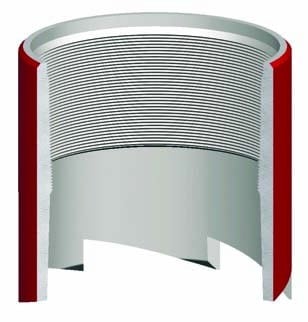Guide shoe and float shoe in drilling are tapered, a commonly bullet-nosed device that is installed at the bottom of any types of casing string. They guide the casing toward the center of the hole to minimize hitting rock ledges or washouts as the casing is run into the well. The outer portions of these shoes are usually made from steel, generally matching the casing sizes and threads. The inside (including the taper) is generally made of concrete or thermoplastic because this material must be drilled out if the well is to be deepened beyond the casing point. Guide shoes and float shoes are made in a wide size range, from 3 1 ⁄2 to 24 in. [8.9 to 61 cm] in diameter, and they are generally used in surface-to-intermediate casing strings at shallow depths.
The drilling guide shoe differs from the float shoe in that it lacks a check valve. The check valve in a float shoe can prevent reverse flow, or U-tubing, of cement slurry from the annulus into the casing. The float shoe also reduces hook weight, because the check valve increases the buoyancy of the casing string by preventing backflow of fluid as the casing is lowered into the well.
Basic Guide Shoe Type
A basic type is shown in Fig. 1. The steel shell is molded into a rounded nose with a central orifice.

Down Jet Casing Guide Shoe
A variation is the “down jet” type. This modification incorporates some side jets or ports to divert all or part of the fluid (Fig. 2). The purpose of the jets or ports is to promote high displacement efficiency by distributing the fluids evenly around the annulus. The jets come in a wide variety of sizes and shapes. The concrete nose is fairly strong, yet can be easily drilled with polycrystalline diamond compact (PDC), insert, and roller cone bits.

Nose Materials And Shapes
Guide shoes and float shoes are available with various nose designs, each built for a specific purpose.
Cement Nose Casing Guide Shoe
Most common in drilling among these is the casing cement nose type. The slightly rounded nose is usually made with high-strength concrete that has a compressive strength of 8,000 and 10,000 psi [5.5 and 6.9 MPa]. The rounded nose allows the casing to be deflected off of ledges and obstructions as the casing is running. The shells of the driling guide shoes and most float equipment have grooves into which the cement flows when poured. As a result, the cement is not held in place by shear bond alone, and it has the strength to withstand the stresses associated with casing placement and the subsequent primary cement job or cement plug job.
Aluminium Nose Shoes
Aluminum nose shoes are another option; however, their popularity has been diminished by the introduction of concrete and composite materials. Aluminum noses can be cast into a wide variety of shapes. Lengthened noses can ease movement past bridges and obstructions downhole (Fig. 3).

Composite Nose Guide Shoes
Composite nose guide shoes are the newest option, made possible by the advent of composite materials that can withstand high load weights and resist abrasion, erosion, and high temperatures (Fig. 4). For example, a typical 9 5/8 -in. eccentric nose float shoe can withstand end loadings greater than 100,000 lbm [45 SI ton] at temperatures exceeding 250°F [121°C]. Their performance exceeds the American Petroleum Institute (API) specifications, and they can withstand running into wellbores up to and beyond 90° inclination.

of Weatherford International).
Texas Pattern
Other types of casing guide shoes include the Texas pattern (beveled nose) and the sawtooth pattern (Fig. 6). The noses of these types are formed or cut out of the steel shell. The beveled nose shoe has the same outside diameter (OD) as the couplings and an inside diameter (ID) that is the same as the casing or drill out diameter. The bevel is advantageous in situations in which it is necessary to pull back the bottom hole assembly through the previous casing. The beveled guide reduces the probability of Pipe sticking.


The beveled nose shoe is most often run in shallow, vertical wells. Such bevels are also incorporated into most float shoes.
In recent years, the price of float shoes has decreased, and many operators use them routinely to have the option of an additional valve in the casing string. However, in deepwater applications, drilling guide shoes are making a comeback. The guide shoes leave an unrestricted path for pipe tripping devices to pass through.
References:
- Well Cementing Second Edition – Erik B. Nelson and Dominique Guillot
Thanks for those great technical materials 🙏. Well done Drilling Manual team 👌.
Thanks